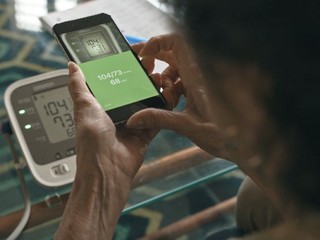Advancing toward a brain on a chip: addressing the need to find therapeutics that work
The webinar included representatives from ACRO Biosystems, Bristol Myers Squibb, and eNuvio
Read more...
In a strange way, healthcare seems to be reverting back to a style that had gone out of fashion many years ago, with an increased amount of health taking place in the home. There are now around 12 million people who are now getting in-home care, from more than 33,000 providers, and last year the annual expenditures for home health care were projected to be over $72 billion.
This is thanks, in large part, to technology and, more specifically, to connected in-home devices that can easily collect and send data to a physicians in real-time. This allows patients to be monitored remotely, without constant trips to the doctor, and for physicians to do more timely interventions based on patterns picked up by AI and machine learning.
In June, Vator, HP and UCSF Health Hub will be holding an event centered around these devices, and how they are affecting the healthtech space. Every week until then we will be doing a roundup of some of the news around in-home devices and what some of the major tech companies are up to in this space.
Humana expands Go365 to more in-home devices
Humana announced that it partnered with Validic to expand its Go365 wellness program to more wearables, health apps, and in-home medical devices, which will give access to more of Humana's populations, including large self-insured employer groups.
Validic is a digital health platform that connects providers, pharmaceutical companies, payers, wellness companies and healthcare IT vendors to health data gathered from hundreds of in-home clinical devices, wearables and consumer healthcare applications.
"The core value for Humana, and companies like them, is not how do they get the data from members across all these different devices? The core value is, what they do once they have the data? And how do they get more data sources on board, so they can have even more information to help folks along in their health journey? Validic solves that key focus of how they get the data so they can focus on what they do with it," Validic CEO Drew Schiller told me in an interview.
"All of these health plans are building their competitive differentiation on what the interventions are and how they engage with members. The competitive differentiator is not that you get data. So, we really solve how they get data, the scale question, and really enable them to utilize all of their internal resources to focus on their key competitive differentiators around how they engage members and improve health in the market."

FDA warns over potential cybersecurity issues in GE connected health devices
The U.S. Food and Drug Administration issued a safety communication to health care providers, facilities and patients about cybersecurity vulnerabilities that the agency identified in certain GE Healthcare Clinical Information Central Stations and Telemetry Servers.
These are devices that are mostly used in health care facilities for displaying patient information, such as the temperature, heartbeat and blood pressure of a patient. They are also used to monitor patients from a central location in a facility, like a nurse’s bay.
The FDA found that hackers could potentially silence alarms, generate false alarms or interfere with the function of patient monitors connected to these devices by remotely taking over the device. So far, there have been no reports of the devices having been hacked.
“Medical devices connected to a communications network can offer numerous advantages over non-connected devices, such as access to more convenient or more timely health care. However, when a medical device is connected to a communications network, there is a risk that cybersecurity vulnerabilities could be exploited by an attacker, which could result in patient harm,” said Suzanne Schwartz, acting director of the Office of Strategic Partnerships and Technology Innovation in the FDA’s Center for Devices and Radiological Health, in a statement.
“The agency understands that cybersecurity is a shared responsibility with the medical device industry, health care delivery organizations, patients, security researchers and other government agencies. Today’s alert regarding cybersecurity vulnerabilities in certain GE Healthcare stations and servers is a key example of the FDA’s commitment to work with all stakeholders to address cybersecurity issues that affect medical devices in order to keep patients safe.”

Can your Fitbit predict the flu?
According to researchers at the Scripps Research Translational Institute, data from users wearing Fitbits might be used to determine where there could potentially be outbreaks of the flu in real time.
The study, which was conducted over two years, from March 2016 to March 2018, used sensor data from 200,000 deidentified people in California, Texas, New York, Illinois, and Pennsylvania (those being the top five states with the most Fitbit users). These are people who wore a Fitbit for at least 60 days and used the same wearable throughout the entire period, which amounted to 47,249 users in all.
Researchers looked at data on resting heart rate (RHR) and sleep data, to see if they could sees trends of what they call "seasonal respiratory infections, such as influenza," as RHR becomes elevated during infection. They concluded that they were able to see "significant improvements" in their ability to predict influenza by tracking this data.
"In the future, wearables could include additional sensors to prospectively track blood pressure, temperature, electrocardiogram, and cough analysis, which could be used to further characterise an individual's baseline and identify abnormalities," the study says.
"Future prospective studies will help to differentiate deviations from an individual's normal levels resulting from infectious versus non-infectious causes, and might even be able to identify infections before symptom onset. Capturing physiological and behavioural data from a growing number of wearable device users globally could greatly improve timeliness and precision of public health responses and even inform individual clinical care. It could also fill major gaps in regions where influenza surveillance data are not available."

Under Armour pulls out of the connected device game for good
Under Armour permanantly discontinued its connected health platform, called HealthBox, which had included an app, wearables, such as a heart rate monitor and wrist-worn activity monitor, as well as a smart scale, none of which will receive software support going forward.
In 2016, the company had partnered with IBM to have Watson power the devices, but the company had stopped manufacturing them by 2017, though it had allowed users to keep using their existing purchases for the next two years.
Under Armour is now encouraging HealthBox users to export their data to MapMyFitness instead, which the company bought in 2015. Not all data can be exported, however, and the MapMyFitness platform only counts calories burned through exercise, rather than all the other data that had previously been captured, including weight, sleep and resting heart rate.
(Image source: digitalhealthsummit.s3.amazonaws.com)
The webinar included representatives from ACRO Biosystems, Bristol Myers Squibb, and eNuvio
Read more...At Invent Health, healthcare execs and investors discuss why infertility rates are so high
Read more...The panel included Genoscience, Emmeline Ventures, Suncoast Ventures, Wisp, and GENESIS Fertility
Read more...Startup/Business
Joined Vator on
Validic provides the industry's leading digital health platform connecting providers, pharmaceutical companies, payers, wellness companies and healthcare IT vendors to health data gathered from hundreds of in-home clinical devices, wearables and consumer healthcare applications. Reaching more than 223 million lives in 47 countries, its scalable, cloud-based solution offers one connection to a continuously-expanding ecosystem of consumer and clinical health data, delivering the standardized and actionable insight needed to drive better health outcomes and power improved population health, care coordination and patient engagement initiatives. Validic was named to Gartner's "Cool Vendors" list and received Frost & Sullivan's "Best Practices and Best Value in Healthcare Information Interoperability" and "Top 10 Healthcare Disruptor" awards. To learn more about Validic, follow Validic on Twitter or visit www.validic.com.

Joined Vator on
Technology and healthcare entrepreneur. Co-founder & CTO at Validic.